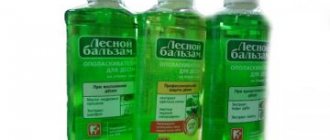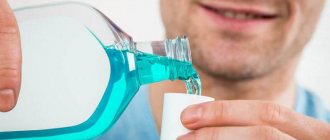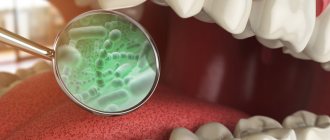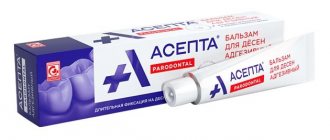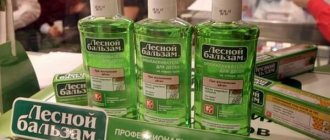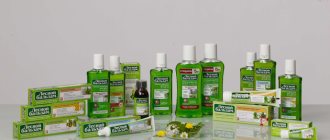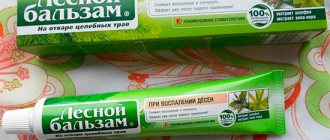Author of the article:
Soldatova Lyudmila Nikolaevna
Candidate of Medical Sciences, Professor of the Department of Clinical Dentistry of the St. Petersburg Medical and Social Institute, Chief Physician of the Alfa-Dent Dental Clinic, St. Petersburg
Oral care is an integral part of hygiene. Many people believe that brushing their teeth is enough to keep them healthy. But improper oral hygiene is the most common cause of diseases of the teeth and gums.
Periodontal diseases constitute the largest group of dental pathologies. To prevent the development of diseases such as gingivitis, periodontitis, stomatitis, a set of products is used to cleanse the oral cavity of bacteria living in dental plaque.
Special rinses for teeth and gums have a good therapeutic and preventive effect.
Causes of bleeding gums
If you are interested in the mechanism of how poor hygiene and gum inflammation lead to bleeding, it looks like this.
Plaque and tartar bacteria produce a large number of toxins and various pathogens that trigger a chain of inflammatory reactions in the gums. In particular, this leads to increased permeability and fragility of capillaries (which is due to the fact that blood appears precisely when brushing teeth), as well as to swelling, redness or cyanosis of the gingival papillae. In parallel with this, the process of desquamation (squamation) of epithelial cells of the gum mucosa intensifies, which leads to thinning of the epithelium. The latter further reduces the resistance of gums weakened by inflammation to mechanical stress, for example, when brushing teeth or chewing hard food. Therefore, when together: 1) fragility and increased permeability of capillaries, 2) thinning of the epithelium + 3) even completely normal mechanical stress, it ends in bleeding when brushing your teeth.
By the way, a very common symptom that accompanies bleeding gums is pain when brushing your teeth. The mechanism of its development is also associated with thinning of the epithelium of the gum mucosa and a decrease in the latter’s resistance to mechanical stress. And the conclusion that needs to be drawn from all of the above is that treatment should not be tied to the fight against a separate symptom of bleeding; it should consist in eliminating the main cause of gum inflammation, i.e. removal of microbial plaque and tartar.
When should you use mouthwash?
With halitosis. If bad breath occurs frequently, a mouthwash will help remove it. It reduces the number of bacteria, slows down their reproduction, and cleans even those areas that cannot be reached with a toothbrush (subgingival, interdental areas, surface of the tongue, gums, cheeks). When rinsing, residues and food particles are washed away, which can cause an unpleasant odor.
If caries appears frequently. It is formed when plaque accumulates on the enamel, when the acidity in the mouth becomes too high (including due to the active growth of bacteria). Antibacterial solutions help reduce acidity, and additional cleansing reduces plaque formation. The mouthwash may contain fluorides or other mineral components that strengthen the enamel, restore its structure, and protect against caries.
With the rapid appearance of tartar. It is formed when soft plaque hardens. It can only be removed with professional cleaning. To prevent tartar from appearing again, effective hygiene is important. Using rinses, you can slow down the formation of deposits: they wash the enamel surface, remove food particles, slow down the growth of bacteria, and help keep teeth clean throughout the day.
If the enamel is highly sensitive. In this case, you need to use solutions with a mineralizing effect. They must contain fluorides. When rinsed, they penetrate the enamel structure, restore it, strengthen it and reduce sensitivity. It’s good if the solution is also antibacterial: it will help reduce acidity in the mouth, eliminating pain.
For bleeding or inflammation of the gums. The use of solutions with anti-inflammatory and antibacterial effects is part of the prevention and treatment of gum disease. They help relieve inflammation, accelerate the healing of the mucous membrane, and slow down the formation of tartar under the gingival margin.
Factors predisposing to bleeding gums
If this is not the first time that you have experienced bleeding, this indicates that your gum inflammation is chronic and has been going on for quite a long time. In this case, when brushing your teeth, blood may appear and then disappear again (24stoma.ru). Typically, gums bleed only during exacerbations of chronic inflammation. Exacerbation of the inflammatory process most often occurs in the off-season and is associated with a decrease in immunity or the development of vitamin deficiency.
But we don’t want you to think that poor immunity or vitamin deficiency are the causes of exacerbations of gum inflammation and bleeding. The cause is still plaque bacteria. It’s just that local protective factors in the oral cavity (against the background of decreased immunity) no longer cope with the previous volume of toxins and pathogens released by microbial plaque on your teeth. Other predisposing factors may include mouth breathing and xerostomia, which contribute to an increase in the amount of plaque in the mouth.
Indications for use
You should know! Refer to the instructions on the back of the bottle for recommendations for use.
Most often, dentists recommend using Forest Balm for:
- Prevention of diseases of the teeth and oral mucosa.
- Eliminate pathogenic bacteria.
- Maintaining local immunity after surgery.
- Acceleration of regenerative processes of mucous tissues.
What diseases are bleeding gums a symptom of?
Bleeding gums can be either an independent disease or a symptom of another. There are three oral diseases that can lead to bleeding:
- Periodontal disease. With periodontal disease, it is not so much the gums that are damaged as the soft tissue around them. Due to the damage to these tissues, which dentists call periodontium, there is an increase in the amount of plaque on the teeth, which leads to microtrauma of the gums. With periodontal disease, tooth pockets do not form, and the gums themselves become inflamed quite rarely.
- Periodontitis. With periodontitis, both the gums and the soft tissue around them are damaged. The disease progresses very quickly. If left untreated, symptoms such as gradual destruction of the alveolar process, inflammation of the gums and soft tissues, formation of dental pockets (which often fester), and so on are observed. Periodontitis is relatively common.
- Gingivitis. Gingivitis causes damage to the gums. If gingivitis is not treated, it evolves into periodontitis.
What is the price?
The price for Forest Balsam products varies depending on the series .
Basic Care mouth rinse costs about 85 rubles , a product from the “ For bleeding gums ” series will cost around 250 rubles.
This pricing is determined by the composition.
For reference! The price of rinses also varies depending on the region of sale and the specific store.
What to do if your gums bleed: treatment
If your gums bleed when brushing your teeth, treatment should be carried out by a periodontist (these doctors do not specialize in the treatment of gums). The most important thing to do at the first stage of treatment is to remove the causative factor in the development of gum inflammation, i.e. carry out ultrasonic cleaning of teeth from microbial plaque and tartar. This can only be done by a dentist. But the course of anti-inflammatory therapy following the cleansing can be carried out at home.
Instructions for use
Important! Forest Balm should be used twice a day, after morning and evening brushing of teeth.
The instructions are as follows:
- Brush your teeth with a brush. Try to remove plaque and get rid of food debris. It would be a good idea to clean the surface of your tongue.
- Spit out the paste and rinse your mouth with water .
- Fill the balm cap about 3/4 full . Place the liquid in your mouth and rinse thoroughly for several minutes. The rinse should wash the inside of the cheeks, tongue and interdental spaces.
Note! In 95% of cases, consumers feel positive dynamics after a week of regular use.
Gums stop bleeding when brushing, and the enamel reacts less to the use of hot and cold.
Treatment at the dentist's office
Treatment of bleeding gums when brushing teeth includes removing plaque from enamel and tartar and rinsing deep periodontal pockets for periodontitis and periodontal disease. These manipulations are carried out by a specialist in the clinic’s office.
To remove dental plaque, ultrasonic cleaning is used, less often - the use of instruments and mechanical cleaning of the enamel. The number of sessions required depends on the complexity of the work and the amount of deposits.
Washing of periodontal pockets is carried out in chronic forms of periodontitis and periodontal disease. It helps remove pathogenic microbes, their waste products, pus and exudate. The solutions used have antibacterial, antimicrobial and anti-inflammatory effects.
Consumer Reviews
An excellent combination of price and quality, natural composition and effectiveness - these components have brought the Forest Balsam mouthwash great popularity among the population.
Let's see what consumers say:
Ekaterina Plotnik, 39 years old.
My husband had terrible gum problems. This is likely due to the fact that he is a heavy smoker.
Every morning, while brushing his teeth, he spat out bloody saliva. On the advice of the dentist, we bought “Forest Balm” from the “For Bleeding Gums” series and it really helped.
Already on the third use, the husband noted that the gums practically did not bleed. Moreover, its enamel became a little lighter. Now we use the rinse and toothpaste “Forest Balsam” with the whole family.
Elena Gordeychik, 31 years old.
I can’t imagine my morning without a cup of strong black coffee, and my lunch without a big glass of latte.
Unfortunately, my addiction to coffee drinks also affected the condition of the enamel - my teeth became noticeably yellower.
Having secured a whitening toothpaste, I began to look for a suitable rinse and my choice fell on “Triple Effect Whitening” from “Forest Balm”.
I was seduced by the natural and harmless composition. The mouthwash works well - my teeth actually became several shades whiter, and there was practically no plaque left.
I think I will continue to use it even after the whitening course.
Gels and toothpastes for bleeding
You should choose a toothpaste based on what is causing your gums to bleed. The composition may contain different components: potassium chloride, sodium sulfate, vitamins, medicinal plants, etc.
The most effective and popular means to solve the problem:
- SPLAT Professional Active is a Russian toothpaste, its distinctive feature is its black color. It has several actions at once - antiseptic, hemostatic. The main components included in the composition are skullcap, spirulina extract, and bergenia extract.
- Lacalut Activ is a whole complex that includes a toothbrush, toothpaste and mouthwash. Aluminum cations are used as a basis.
- Parodontax Classic – contains extracts of medicinal herbs. The pasta is produced not in our country, but in the UK.
- Forest balsam is another domestic product that contains many components of plant origin. There is sea buckthorn essential oil, St. John's wort, chamomile and more.
Recommended toothpaste for treatment
Dental gels are no less effective. It is recommended to use Cholisal, Parodium, Solcoseryl, Metrogil Dent, etc.
Interesting!
It is recommended to change toothpastes periodically, this way you can achieve comprehensive care.
Whitening pastes should never be used for bleeding gums. The thing is that they can irritate the gums, thereby further aggravating the situation. In the video in this article you can learn in more detail about which toothpastes and gels are useful for this problem.
Contraindications
Despite the obvious advantages of use, “Forest Balm” cannot be used by everyone.
In some cases, the rinse aid is contraindicated for use:
- During pregnancy and lactation - available only after consultation with a doctor. May cause nausea due to toxicosis.
- Allergy or hypersensitivity to the main components of the drug .
- Children under 7 years of age - the ban is due to the risk of swallowing an alcohol-containing composition and burning the esophagus.
Antiseptics for rinsing
Mouth rinse
To rinse the mouth, you should take products with antibacterial and anti-inflammatory effects. In order to enhance overall healing, they are usually used as a supplement.
So, what do dentists recommend:
- Miramistin 0.01%. The drug is especially effective for herpes infections, has a calming and antimicrobial effect.
- Stomatophyte – contains medicinal herbs and alcohol. Recommended for use in the development of gingivitis and periodontal disease.
- Polyminerol – stops bleeding, accelerates regeneration processes.
- Chlorhexidine, concentration not more than 0.05%. This is an antibacterial agent used for inflammatory processes. In addition, dentists recommend rinsing your mouth with it after tooth extraction.
- Chlorophyllipt is based on an extract of eucalyptus leaves. It is prescribed when the oral cavity is affected by pathogenic staphylococci.
- Maraslavin. Contains wormwood herb, savory, black pepper. Helps relieve pain, eliminates allergy symptoms.
- Periodonticide. It contains a large number of medicinal herbs, due to this it has a good anti-inflammatory effect.
To achieve the desired result, rinses should be used in a course. Moreover, one product cannot be used for more than a month. The thing is that many bacteria can develop resistance.
Folk remedies for bleeding gums
After consulting with your doctor, you can also use some traditional medicine that eliminate existing bleeding no worse than medications.
1. Oak bark. This is one of the simplest and at the same time effective means of treating bleeding gums. This bark is rich in tannins, which strengthen the gums and prevent their bleeding. For treatment, just take 1 tbsp. crushed oak bark, pour 100 ml of boiling water and put on fire. Keep the product on the fire for 7 minutes, then remove and let it cool. Rinse your mouth with this medicine 2 times a day.
2. Chamomile. This flower boasts excellent anti-inflammatory properties, which eliminates the cause of gingival bleeding caused by the inflammatory process. Take 1 tbsp. chamomile flowers and load into a thermos. Fill the healing plant with 250 ml of boiling water, close the lid of the thermos and leave the product for 4 hours. Let it cool, and then strain the medicine and you can rinse your mouth with it after meals 3 times a day.
3. Sage. Another natural remedy that is extremely beneficial for oral health is sage. To get rid of bleeding gums you will need to take 2 tbsp. dry sage leaves and irritate them with 400 ml of boiling water. Leave the finished mixture to infuse for half an hour, then strain and rinse your mouth with the mixture twice a day, morning and evening.
Let us only add that the considered folk remedies should not be the only medicines in the fight against bleeding gums. They can only be used in combination with medications prescribed by a doctor.
How can diet help treat gums?
If your gums bleed when brushing your teeth, treatment should begin immediately. In addition to drug therapy, it is important to maintain proper nutrition. The patient needs to reduce the consumption of sugar and fatty foods. Regardless of age, it is important to get enough vitamins. Doctors recommend including in your diet: vegetables, fruits, fish, cheeses, cottage cheese. The dentist may prescribe a multivitamin supplement.
For treatment to be effective, you cannot exclude from your diet food containing calcium, phosphorus, and vitamins: C, E, B1 and B2. These components strengthen teeth and soft gum tissue. It is forbidden to eat spicy, sour foods. It irritates the mucous membrane. You should also not eat crackers, caramel, nuts, etc. When chewed, these products can injure the gums, after which bacteria will enter the wounds and the inflammatory process will begin.
In addition, doctors urge you to stop smoking and drinking alcohol.
